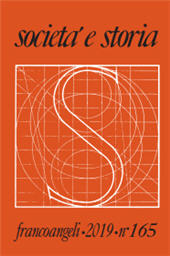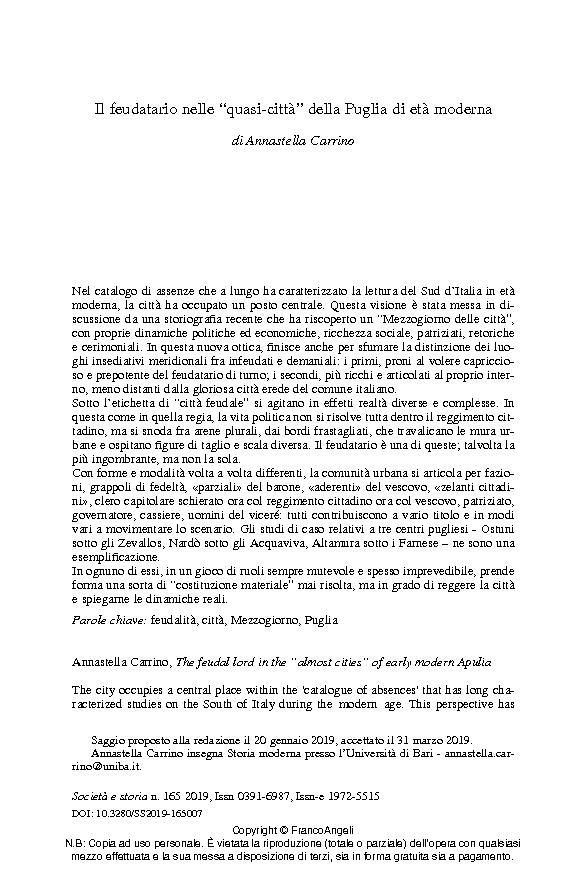Il feudatario nelle quasi-città della Puglia di età moderna
503-522 p.
Nel catalogo di assenze che a lungo ha caratterizzato la lettura del Sud d'Italia in età moderna, la città ha occupato un posto centrale. Questa visione è stata messa in discussione da una storiografia recente che ha riscoperto un "Mezzogiorno delle città", con proprie dinamiche politiche ed economiche, ricchezza sociale, patriziati, retoriche e cerimoniali. In questa nuova ottica, finisce anche per sfumare la distinzione dei luoghi insediativi meridionali fra infeudati e demaniali: i primi, proni al volere capriccioso e prepotente del feudatario di turno; i secondi, più ricchi e articolati al proprio interno, meno distanti dalla gloriosa città erede del comune italiano. Sotto l'etichetta di "città feudale" si agitano in effetti realtà diverse e complesse. In questa come in quella regia, la vita politica non si risolve tutta dentro il reggimento cittadino, ma si snoda fra arene plurali, dai bordi frastagliati, che travalicano le mura urbane e ospitano figure di taglio e scala diversa.
Il feudatario è una di queste; talvolta la più ingombrante, ma non la sola. Con forme e modalità volta a volta differenti, la comunità urbana si articola per fazioni, grappoli di fedeltà, «parziali» del barone, «aderenti» del vescovo, «zelanti cittadini », clero capitolare schierato ora col reggimento cittadino ora col vescovo, patriziato, governatore, cassiere, uomini del viceré: tutti contribuiscono a vario titolo e in modi vari a movimentare lo scenario. Gli studi di caso relativi a tre centri pugliesi Ostuni sotto gli Zevallos, Nardò sotto gli Acquaviva, Altamura sotto i Farnese ne sono una esemplificazione. In ognuno di essi, in un gioco di ruoli sempre mutevole e spesso imprevedibile, prende forma una sorta di "costituzione materiale" mai risolta, ma in grado di reggere la città e spiegarne le dinamiche reali. [Testo dell'editore].
The city occupies a central place within the 'catalogue of absences' that has long characterized studies on the South of Italy during the modern age. This perspective has been challenged by recent historiography, which has rediscovered a "Mezzogiorno of the cities", with its own political and economic dynamics, social wealth, patriciates, rhetoric and ceremonies. From this new perspective, the gap between fiefdoms and postfeudal political entities in southern townships begins to close. The former were subject to the capricious and arrogant rule of the incumbent feudal lord. The latter were richer, better structured internally, and closer to the glorious city that was the successor to the Italian commune. Diverse and complex realities coexist under the label of "feudal city2. In this, as in cities within kingdoms, political life is not confined to its rulers, but is spread across multiple areas with porous edges that go beyond urban walls and accommodate people of different calibre and social standing.
The feudal lord can be counted among them: sometimes he is the most troublesome, but he is not alone in this. The urban community (sometimes in different forms and modes) is organized into factions, loyal groups, 'favourites' of the baron, "followers" of the bishop, zealous citizens, a diocesan chapter (siding sometimes with the civic authorities and sometimes with the local bishop), the patriciate, the governor, the treasurer, the viceroy's men. All contribute (for different reasons and in various ways) to keep the show on the road. An illustration of this can be observed in case studies relating to three Apulian centres Ostuni (under the Zevallos family), Nardò (under the Acquaviva family), and Altamura (under the Farnese family). In each of them, in a game where roles are constantly changing and often unpredictable, a kind of "unwritten constitution" takes shape, never resolved but capable of ruling the city and eliciting the real dynamics therein. [Publisher's text].
Is part of
Società e storia : 165, 3, 2019-
Articles from the same issue (available individually)
-
Information
ISSN: 1972-5515
KEYWORDS
- Feudalità, città, Mezzogiorno, Puglia
- Feudalism, Town, South of Italy, Apulia



